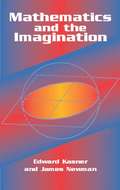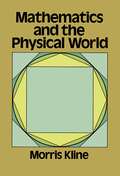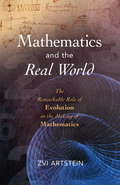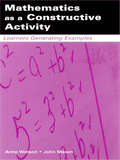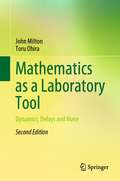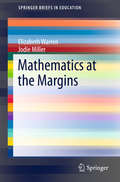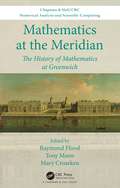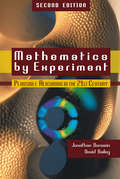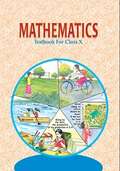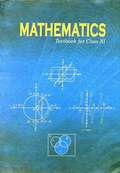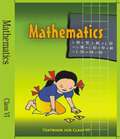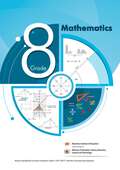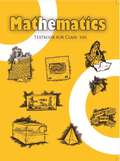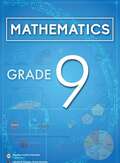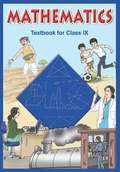- Table View
- List View
Mathematics and the Imagination (Dover Books on Mathematics)
by James Newman Edward KasnerAnyone who gambles, plays cards, loves puzzles, or simply seeks an intellectual challenge will love this amusing and thought-provoking book. With wit and clarity, the authors deftly progress from simple arithmetic to calculus and non-Euclidean geometry. "Charming and exciting." -- Saturday Review of Literature. Includes 169 figures.
Mathematics and the Mind
by Hassan TahiriThis book examines how epistemology was reinvented by Ibn Sīnā, an influential philosopher-scientist of the classical Islamic world who was known to the West by the Latinised name Avicenna. It explains his theory of knowledge in which intentionality acts as an interaction between the mind and the world. This, in turn, led Ibn Sīnā to distinguish an operation of intentionality specific to the generation of numbers. The author argues that Ibn Sīnā's transformation of philosophy is one of the major stages in the de-hellinisation movement of the Greek heritage that was set off by the advent of the Arabic-Islamic civilisation. Readers first learn about Ibn Sīnā's unprecedented investigation into the concept of the number and his criticism of such Greek thought as Plato's realism, Pythagoreans' empiricism, and Ari stotle's conception of existence. Next, coverage sets out the basics of Ibn Sīnā's theory of knowledge needed for the construction of numbers. It describes how intentionality turns out to be key in showing the ontological dependence of numbers as well as even more critical to their construction. In describing the various mental operations that make mathematical objects intentional entities, Ibn Sīnā developed powerful arguments and subtle analyses to show us the extent our mental life depends on intentionality. This monograph thoroughly explores the epistemic dimension of this concept, which, the author believes, can also explain the actual genesis and evolution of mathematics by the human mind.
Mathematics and the Physical World
by Morris Kline"Kline is a first-class teacher and an able writer. . . . This is an enlarging and a brilliant book." - Scientific American"Dr. Morris Kline has succeeded brilliantly in explaining the nature of much that is basic in math, and how it is used in science." - San Francisco ChronicleSince the major branches of mathematics grew and expanded in conjunction with science, the most effective way to appreciate and understand mathematics is in terms of the study of nature. Unfortunately, the relationship of mathematics to the study of nature is neglected in dry, technique-oriented textbooks, and it has remained for Professor Morris Kline to describe the simultaneous growth of mathematics and the physical sciences in this remarkable book. In a manner that reflects both erudition and enthusiasm, the author provides a stimulating account of the development of basic mathematics from arithmetic, algebra, geometry, and trigonometry, to calculus, differential equations, and the non-Euclidean geometries. At the same time, Dr. Kline shows how mathematics is used in optics, astronomy, motion under the law of gravitation, acoustics, electromagnetism, and other phenomena. Historical and biographical materials are also included, while mathematical notation has been kept to a minimum. This is an excellent presentation of mathematical ideas from the time of the Greeks to the modern era. It will be of great interest to the mathematically inclined high school and college student, as well as to any reader who wants to understand - perhaps for the first time - the true greatness of mathematical achievements.
Mathematics and the Real World
by Zvi ArtsteinIn this accessible and illuminating study of how the science of mathematics developed, a veteran math researcher and educator looks at the ways in which our evolutionary makeup is both a help and a hindrance to the study of math.Artstein chronicles the discovery of important mathematical connections between mathematics and the real world from ancient times to the present. The author then describes some of the contemporary applications of mathematics--in probability theory, in the study of human behavior, and in combination with computers, which give mathematics unprecedented power.The author concludes with an insightful discussion of why mathematics, for most people, is so frustrating. He argues that the rigorous logical structure of math goes against the grain of our predisposed ways of thinking as shaped by evolution, presumably because the talent needed to cope with logical mathematics gave the human race as a whole no evolutionary advantage. With this in mind, he offers ways to overcome these innate impediments in the teaching of math.
Mathematics as a Constructive Activity: Learners Generating Examples (Studies in Mathematical Thinking and Learning Series)
by John Mason Anne WatsonThis book explains and demonstrates the teaching strategy of asking learners to construct their own examples of mathematical objects. The authors show that the creation of examples can involve transforming and reorganizing knowledge and that, although this is usually done by authors and teachers, if the responsibility for making examples is transferred to learners, their knowledge structures can be developed and extended. A multitude of examples to illustrate this is provided, spanning primary, secondary, and college levels. Readers are invited to learn from their own past experience augmented by tasks provided in the book, and are given direct experience of constructing examples through a collection of many tasks at many levels. Classroom stories show the practicalities of introducing such shifts in mathematics education. The authors examine how their approach relates to improving the learning of mathematics and raise future research questions.*Based on the authors' and others' theoretical and practical experience, the book includes a combination of exercises for the reader, practical applications for teaching, and solid scholarly grounding.*The ideas presented are generic in nature and thus applicable across every phase of mathematics teaching and learning.*Although the teaching methods offered are ones that engage learners imaginatively, these are also applied to traditional approaches to mathematics education; all tasks offered in the book are within conventional mathematics curriculum content.Mathematics as a Constructive Activity: Learners Generating Examples is intended for mathematics teacher educators, mathematics teachers, curriculum developers, task and test designers, and classroom researchers, and for use as a text in graduate-level mathematics education courses.
Mathematics as a Laboratory Tool: Dynamics, Delays and Noise
by John Milton Toru OhiraThe second edition of Mathematics as a Laboratory Tool reflects the growing impact that computational science is having on the career choices made by undergraduate science and engineering students. The focus is on dynamics and the effects of time delays and stochastic perturbations (“noise”) on the regulation provided by feedback control systems. The concepts are illustrated with applications to gene regulatory networks, motor control, neuroscience and population biology. The presentation in the first edition has been extended to include discussions of neuronal excitability and bursting, multistability, microchaos, Bayesian inference, second-order delay differential equations, and the semi-discretization method for the numerical integration of delay differential equations. Every effort has been made to ensure that the material is accessible to those with a background in calculus. The text provides advanced mathematical concepts such as the Laplace and Fourier integral transforms in the form of Tools. Bayesian inference is introduced using a number of detective-type scenarios including the Monty Hall problem.
Mathematics at the Margins
by Elizabeth Warren Jodie MillerThis book reports the impact a four-year longitudinal study (Representations, Oral Language and Engagement in Mathematics (RoleM)) had on teachers and students from 16 schools in disadvantaged contexts. It offers theories with regard to the interplay between teaching and learning mathematics as teachers and students in these contexts implement a mathematics program. The data are longitudinal, drawn from 154 teachers and their students (up to 1738 students) from the first four years of school (Foundation to Year 3). To ascertain the effectiveness of the RoleM Professional Learning model, teachers were interviewed three times a year and pre and post-tests were administered to students at the beginning and end of each year. Students' results indicated that all students' understanding of mathematics improved significantly, with the ESL students showing the greatest gains. Their results matched the norm-referenced expectations for all Australian students of this age. This book shares the journey of these teachers, Indigenous teacher aides and students. It outlines the dimensions of the research findings that supported teachers to become effective teachers of mathematics and assisted students in becoming successful learners of mathematics. The book also draws on the expertise of researchers from both Canada and New Zealand. They share the similarities and the differences between RoleM findings and their own contexts, in order to draw general conclusions for the effective teaching and learning of mathematics at the margins of society.
Mathematics at the Meridian: The History of Mathematics at Greenwich (Chapman & Hall/CRC Numerical Analysis and Scientific Computing Series)
by Raymond Flood Tony Mann Mary CroarkenGreenwich has been a centre for scientific computing since the foundation of the Royal Observatory in 1675. Early Astronomers Royal gathered astronomical data with the purpose of enabling navigators to compute their longitude at sea. Nevil Maskelyne in the 18th century organised the work of computing tables for the Nautical Almanac, anticipating later methods used in safety-critical computing systems. The 19th century saw influential critiques of Charles Babbage’s mechanical calculating engines, and in the 20th century Leslie Comrie and others pioneered the automation of computation. The arrival of the Royal Naval College in 1873 and the University of Greenwich in 1999 has brought more mathematicians and different kinds of mathematics to Greenwich. In the 21st century computational mathematics has found many new applications. This book presents an account of the mathematicians who worked at Greenwich and their achievements. Features A scholarly but accessible history of mathematics at Greenwich, from the seventeenth century to the present day, with each chapter written by an expert in the field The book will appeal to astronomical and naval historians as well as historians of mathematics and scientific computing.
Mathematics by Experiment: Plausible Reasoning in the 21st Century
by David Bailey Jonathan BorweinThis revised and updated second edition maintains the content and spirit of the first edition and includes a new chapter, "Recent Experiences", that provides examples of experimental mathematics that have come to light since the publication of the first edition in 2003. For more examples and insights, Experimentation in Mathematics: Computational P
Mathematics class 10 - Andhra Pradesh Board
by Hyderabad Government of Andhra PradeshAndhra Pradesh board Mathematics text book for standard 10
Mathematics class 10 - Meghalaya Board
by Meghalaya Board of School EducationCreated and published by the Meghalaya School Board of School Education, the textbook for class 10 helps the students to understand various basics for higher level maths and prepare them for the examinations. Written in simple english language the book is full of solved examples for the students to understand the concept better.
Mathematics class 10 - NCERT - 23
by National Council of Educational Research and TrainingThe NCERT Mathematics Textbook for Class X, designed for the 10th grade students in India under the CBSE, covers essential topics to build foundational knowledge. It begins with "Real Numbers", introducing Euclid’s Division Lemma, the Fundamental Theorem of Arithmetic, and delving into the nature of irrational numbers and the decimal representation of rational numbers. The "Polynomials" section provides a geometrical interpretation of the zeros of a polynomial, explores the relationship between zeros and coefficients, and covers polynomial division. Subsequent chapters introduce students to linear equations, quadratic equations, arithmetic progressions, and coordinate geometry, among other topics. The textbook also delves into trigonometry, touching upon various trigonometric identities and their applications. Basic concepts of geometry, like circles and constructions, are elucidated with precision. The textbook ends by acquainting students with probability, statistics, and applications of real-world problems. Overall, it provides a comprehensive overview of fundamental mathematical concepts, preparing students for more advanced studies.
Mathematics class 10 - Tamil Nadu Board
by Textbook board of Government of Tamil NaduThe 10th standard mathematics textbook by the Tamil Nadu Government offers a comprehensive guide to essential mathematical concepts. It covers Algebra, Geometry, Trigonometry, Statistics and Probability, Mensuration, and Coordinate Geometry, emphasizing conceptual clarity with detailed explanations and examples. Each chapter includes ample practice problems, real-life applications, and step-by-step solutions to reinforce learning. The book also features model questions and previous years' exam questions to aid in board exam preparation, ensuring students build a strong foundation in mathematics.
Mathematics class 11 - NCERT - 23
by National Council of Educational Research and TrainingNCERT's Class 11 Mathematics book provides a comprehensive foundation in fundamental math concepts and their applications. It covers sets, functions, algebra, coordinate geometry, calculus, mathematical reasoning, statistics, and probability. With a practical approach, it builds problem-solving skills and logical thinking. Through examples and exercises, students connect theory to real-life scenarios. An invaluable resource for exam preparation and future math studies.
Mathematics class 6 - NCERT - 23
by National Council of Educational Research and TrainingThe NCERT Mathematics textbook for Class VI serves as a comprehensive guide introducing fundamental mathematical concepts to students. The book is structured to provide a strong foundation in arithmetic, geometry, and basic algebraic concepts. It begins by laying a solid groundwork in numbers, focusing on understanding whole numbers, fractions, decimals, and their operations. The textbook then progresses to explore geometry, covering shapes, lines, angles, and symmetry, encouraging visual learning and problem-solving. Furthermore, it introduces students to basic algebraic concepts through patterns, equations, and understanding of variables. Each chapter is designed with clarity, using practical examples, illustrations, and exercises to reinforce learning. The book aims to not only impart mathematical knowledge but also foster critical thinking, problem-solving skills, and an appreciation for the application of mathematics in everyday life.
Mathematics class 7 - Himachal Pradesh Board
by Himachal Pradesh Board of School Education DharamshalaThe Himachal Pradesh Board of School Education's Class VII Mathematics textbook, published with the permission of NCERT, aims to make learning mathematics engaging and comprehensive. The textbook emphasizes understanding mathematical concepts through practical applications and problem-solving strategies rather than rote memorization. It encourages teachers to create a collaborative classroom environment where students can explore, discuss, and develop their own mathematical frameworks. The book covers topics such as integers, fractions, and geometry, linking them to prior knowledge while introducing new concepts. This approach helps students build confidence and reduces the fear associated with learning mathematics.
Mathematics class 7 - MIE
by Mauritius Institute of EducationThe Grade 7 Mathematics textbook, authored by Professor Vassen Naëck and a team from the Mauritius Institute of Education, serves as a vital resource in aligning with the National Curriculum Framework, guiding students through a seamless transition from Grade 6 to secondary education. Its comprehensive content spans Numbers, Algebra, Measures, Geometry, and Probability + Statistics, emphasizing problem-solving and real-world applications. Utilizing a pedagogical approach that prioritizes sense-making and reasoning, the textbook integrates digital tools like GeoGebra to deepen understanding. With various icons highlighting activities, exercises, and notes, the text promotes interactive and engaging learning experiences, fostering a deeper comprehension of mathematical concepts.
Mathematics class 7 - NCERT - 23
by National Council of Educational Research and TrainingThe NCERT Class 7 Mathematics textbook provides a comprehensive and structured approach to mathematical concepts for students. It covers a wide range of topics, including integers, fractions, decimals, geometry, algebra, and data handling. The book aims to develop a strong foundation in mathematical principles by introducing students to real-life applications and problem-solving techniques. Through engaging and interactive exercises, the textbook encourages active participation, fostering a deeper understanding of mathematical concepts. It emphasizes conceptual clarity, logical reasoning, and practical application, preparing students for more advanced mathematical studies. Additionally, the textbook incorporates activities that promote critical thinking, making the learning process enjoyable and meaningful for Class 7 students. Overall, the NCERT Class 7 Mathematics textbook is designed to instill a love for mathematics while equipping students with essential skills for their academic journey.
Mathematics class 8 - MIE
by Mauritius Institute of EducationThe Grade 8 Mathematics textbook by the Mauritius Institute of Education, published in 2021, presents a comprehensive curriculum aligned with the National Curriculum Framework. It covers diverse mathematical topics, including number sequences, indices, rate and proportion, coordinates, algebra, and geometry. Each chapter begins with clear learning objectives and provides ample exercises, examples, and summaries to aid comprehension. Emphasizing real-life applications, the textbook illustrates concepts such as Fibonacci sequences in nature and architectural scales, fostering contextual learning. The educational content is meticulously crafted to enhance learners' cognitive skills through practical activities and contextualized problem-solving. This textbook serves as an invaluable resource for Grade 8 students, facilitating their mathematical understanding and application in various real-world scenarios.
Mathematics class 8 - NCERT - 23
by National Council of Educational Research and TrainingThe Mathematics textbook for Class VIII by NCERT provides a comprehensive and structured approach to fundamental mathematical concepts for students at the eighth-grade level. The textbook covers a wide range of topics, including number systems, algebraic expressions and equations, geometry, mensuration, data handling, and practical geometry. With a focus on building problem-solving skills, the book incorporates real-life examples and engaging exercises to enhance students' understanding of mathematical principles. Through a balanced mix of theory and application, it aims to develop a solid foundation in mathematics, promoting logical reasoning and analytical thinking. The textbook aligns with the NCERT curriculum, ensuring that students acquire a strong mathematical foundation that will serve as a basis for their academic journey.
Mathematics class 8 - Tamil Nadu Board
by State Council of Educational Research and TrainingThe Tamil Nadu 8th Standard Mathematics textbook, part of the Free Textbook Programme by the Government of Tamil Nadu and revised in 2019, 2020, 2022, and 2023, emphasizes understanding over rote learning. It covers Numbers, Measurements, Algebra, Life Mathematics, Geometry, Statistics, and Information Processing. The book includes interactive activities, ICT corners, and exercises to apply mathematical concepts in real life. Key features like ‘Do you know?’, ‘Try this/these’, and ‘Mathematics Alive’ aim to enhance curiosity and understanding. Designed to mathematize a child’s thought process, it demonstrates the ubiquity of mathematics in nature and everyday life, fostering deep comprehension and engagement.
Mathematics class 9 - Goa Board
by National Council of Educational Research and TrainingThe Class IX Mathematics textbook by NCERT (National Council of Educational Research and Training) is a comprehensive resource designed to provide students with a strong foundation in mathematical concepts. The book covers a wide array of topics, including real numbers, polynomials, coordinate geometry, linear equations in two variables, Euclid's geometry, lines and angles, triangles, quadrilaterals, areas of parallelograms and triangles, circles, constructions, surface areas and volumes, statistics, and probability. Each chapter is meticulously structured to foster a deep understanding of mathematical principles, offering clear explanations, solved examples, and exercises that progressively challenge students' skills. The textbook emphasizes problem-solving strategies, logical reasoning, and practical applications, ensuring that students not only grasp mathematical theories but also develop problem-solving skills crucial for real-life situations. Additionally, it aligns with the NCERT curriculum, providing a balanced approach to mathematical concepts that encourages students to explore, analyze, and appreciate the beauty and utility of mathematics in everyday life.
Mathematics class 9 - MIE
by Mauritius Institute of EducationPublished by the Mauritius Institute of Education in 2021, the Grade 9 mathematics textbook offers a comprehensive alignment with the National Curriculum Framework, prioritizing the enhancement of learners' cognitive abilities through contextualized materials. Covering a range of topics including indices, binomial expressions, quadratics, and algebraic manipulation, the textbook incorporates exercises and continuous assessments to reinforce learning. Rooted in Variation Theory, the pedagogical approach aims to facilitate students' discernment of key concepts within each topic, fostering procedural fluency. This collaborative effort between MIE academics and seasoned educators ensures the delivery of high-quality content that effectively meets educational objectives, providing students with a solid foundation in mathematics.
Mathematics class 9 - NCERT
by National Council of Educational Research and TrainingMathematics Textbook For Class IX has been designed in a way so as to enable students to tackle difficult mathematical problems with ease. Published by NCERT, this book comprehensively covers the curriculum for the CBSE board and provides convenient ways of solutions to various numerical problems. The textbook has copious diagrams and solved examples to facilitate easier understanding and better adaptability among students. Unnecessary jargon is kept at bay, making mathematics more interesting for the students. Every topic is supported with abundant solved examples and practice sums to constitute a complete learning experience.
Mathematics class 9 - NCERT- 23
by National Council of Educational Research and Training"Mathematics: Class 9" by NCERT is a comprehensive textbook designed to facilitate a deeper understanding of fundamental mathematical concepts for students at the ninth-grade level. The book covers a wide range of topics including number systems, algebraic expressions, geometry, statistics, and probability. Each chapter is structured to provide clear explanations, examples, and exercises to reinforce learning. It emphasizes problem-solving skills, critical thinking, and mathematical reasoning through practical applications and real-life scenarios. With its systematic approach and engaging presentation, the textbook aims to equip students with the necessary skills and knowledge to excel in mathematics and build a strong foundation for future learning in the subject.
